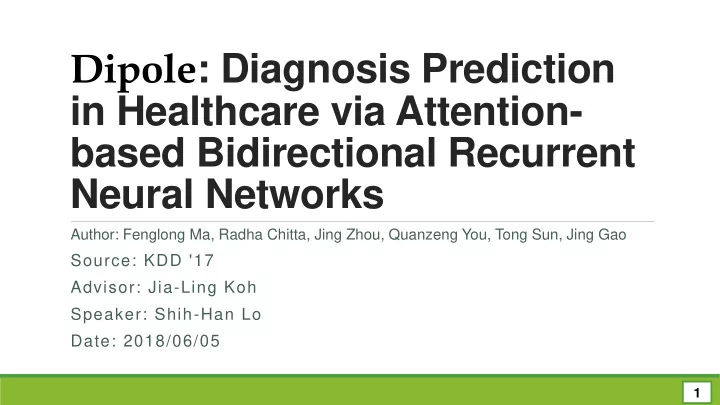

Dipole : Diagnosis Prediction in Healthcare via Attention- based Bidirectional Recurrent Neural Networks Author: Fenglong Ma, Radha Chitta, Jing Zhou, Quanzeng You, Tong Sun, Jing Gao Source: KDD '17 Advisor: Jia-Ling Koh Speaker: Shih-Han Lo Date: 2018/06/05 1
Outline Introduction Method Experiment Conclusion 2
Motivation 3
Goal Electronic Learn Health interpretable Records representations Improve the accuracy, provide better interpretation (Especially when the length of the visits is large) 4
Basic Notations All unique medical codes from the EHR data: Sequence of visits from the n-th patient: Binary vector of medical codes: Category representation: 5
Outline Introduction Method Experiment Conclusion 6
Proposed Model 7
Visit Embedding Given a visit 𝒚 𝑗 , we can obtain its vector representation as follows: 8
Bidirectional Recurrent Neural Networks Structure of unidirectional RNN: 9
Bidirectional Recurrent Neural Networks Structure of bi directional RNN: 𝑔 𝑔 10
Attention Mechanism 1. Location-based Attention: 2. General Attention: 3. Concatenation-based Attention: 11
Attention Mechanism Attention weight vector 𝜷 𝑢 : Context vector 𝒅 𝑢 : 12
Diagnosis Prediction Attentional hidden state (attentional vector): The attentional vector is fed to the softmax layer to produce ( t+1 )-th visit information: 13
Objective Function Cross entropy to calculate the loss for all the patients: Ground truth visit Predicted visit 14
Interpretation The top k codes with the largest values are selected: 15
Interpretation 16
Outline Introduction Method Experiment Conclusion 17
Datasets 18
Results of Diagnosis Prediction 19
Results of Diagnosis Prediction 20
Assumption Validation 21
Outline Introduction Method Experiment Conclusion 22
Conclusion By employing bi directional recurrent neural networks ( B RNN), Dipole can remember the hidden knowledge learned from the previous and future visits. Attention Mechanisms allow us to interpret the prediction results reasonably. 23
Recommend
More recommend